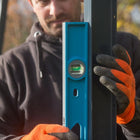Concrete Fence Post Problems - Sounding The Last Post For Concrete

Concrete has been a building material since time immemorial. Desert traders in North Africa used materials similar to modern concrete to build underground water cisterns. More recently, although since centuries ago, the Romans used it as a go-to building material for just about everything they wanted to build to last, including the baths, aqueducts, even the Colosseum.
But, whilst many of these Roman structures last and look good even today, modern concrete simply struggles to stay the course. When it comes to concrete fence posts the average life expectancy is only around 20 years. What did the Romans know that we seem to have lost
CHECK YOUR POST – WHAT’S IN THE MIX?
In general concrete is a mixture of cement, sand, aggregate and water. Proportions vary for different jobs. Where the Romans may have had an advantage is that their concrete included something called pozzolana (volcanic ash) and chunks of tuffa (volcanic rock). This seems to give their concrete the virtue of longevity.
Interestingly, unlike modern-day concrete – usually mixed 1 part cement to 2 parts sand and 4 parts aggregate – the Romans didn’t use any metal reinforcing. Your common or garden concrete fencepost will have metal rods running through it for greater strength. The most superb example of Roman concrete is The Pantheon, in the eternal city itself, which Michelangelo described as ‘angelic and not of human design’. It looks modern even to this day and remains the largest non-reinforced concrete dome in the world.

SEND FOR REINFORCEMENTS? PERHAPS NOT.
Perhaps surprisingly it is the very fact that concrete fenceposts are reinforced with metal that causes major weakness. For all its toughness concrete can be a fairly friable substance, not immune to chips and cracks. When that happens water can get in, the frost can get to work opening cracks still further and the metal rods become exposed and corrode.
As ever the damage is normally done at the bottom of the fence, near the ground. From then on it only takes a stiff wind to work the cracks bigger, and the process continues ad infinitum until the fence starts to lean and eventually fall over. The cracks are not really fixable and look rather ugly.
A WEIGHT ON YOUR SHOULDERS AND NON-ENVIRONMENTALLY FRIENDLY
It is possible to fit a concrete spur to shore up a broken concrete post but that’s all rather heavy-duty work In fact everything to do with concrete fence posts is heavy work – due to the intrinsic weight of the post it takes at least two and often three people to install them in the first place. Attaching a concrete spur involves drills and bolts and at least two pairs of hands to keep the fence upright whilst the spur is fixed.
You’ll definitely feel the weight when your concrete fencepost comes to the end of its life when you have to dig it out of the ground and cart it down to the tip to consign it to landfill. Concrete may have been one of the great building materials in recent history but, moving forward, its environmental credentials look increasingly fragile.
CONCRETE REASONS TO USE DURAPOST’S
If you want to avoid the installation and potential pitfalls of concrete (or wooden) fenceposts, then check out the DuraPost™ range. Made in the UK from galvanised steel in a wide range of contemporary colours DuraPost™ fence posts won’t rot, warp or crack and are maintenance free. That’s why we’re confident in giving them a 25-year guarantee.
Finally, they’re not only 80% lighter than concrete equivalents, they are 100% recyclable at end-of-life, giving you an environmentally friendly and sustainable choice for your fence. That means you can not only take the weight off your shoulders, you can give yourself a pat on the back!

DuraPost® fencing systems
Create Extraordinary Spaces
DuraPost® steel fence posts and composite fence panels. Find out why they are the ultimate fencing system.






